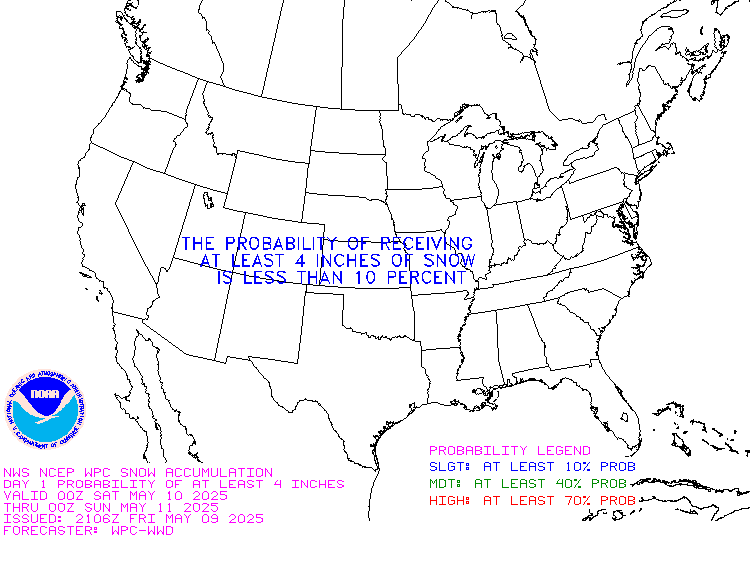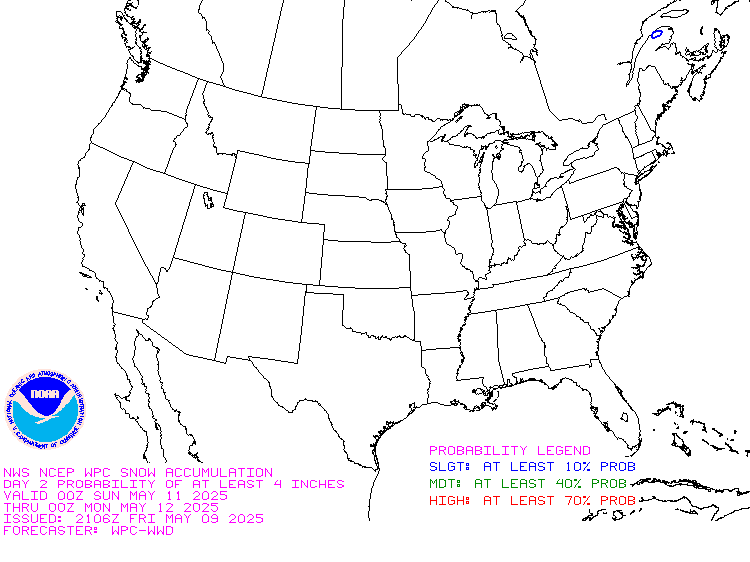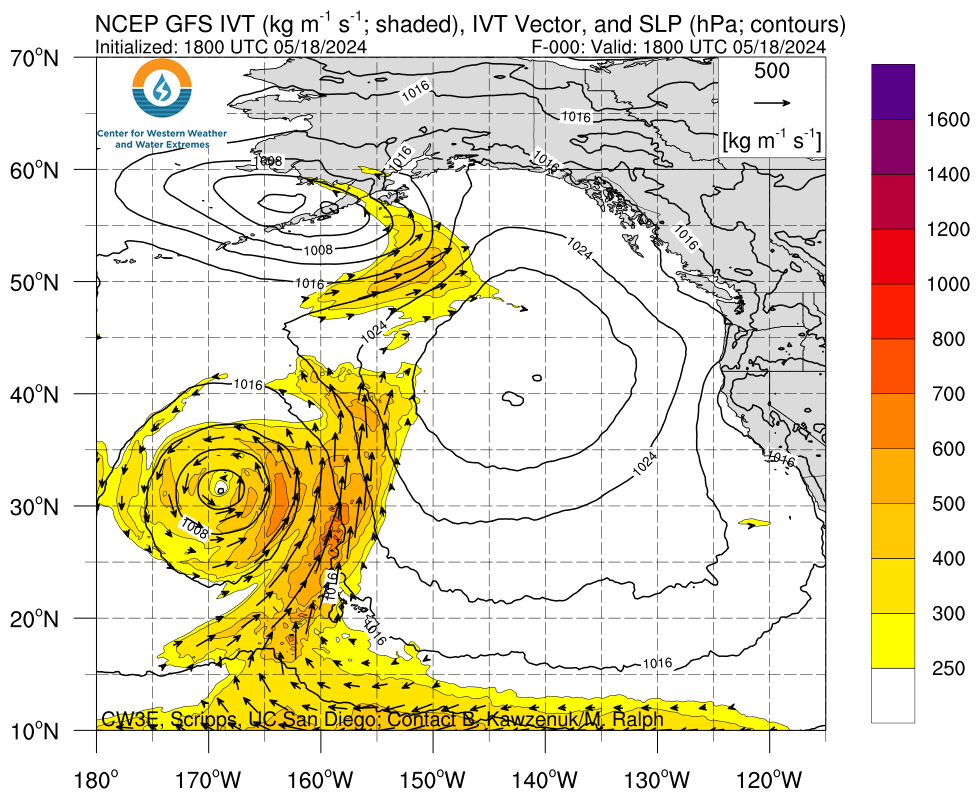This article focuses on what we are paying attention to in the next 48 to 72 hours. The article also includes weather maps for longer-term U.S. outlooks and a six-day World weather outlook which can be very useful for travelers.
First the NWS Short Range Forecast. The afternoon NWS text update can be found here but it is unlikely to have changed very much. The images in this article automatically update.
Short Range Forecast Discussion
NWS Weather Prediction Center College Park MD
Mon May 20 2024
Valid 12Z Mon May 20 2024 – 12Z Wed May 22 2024…Continued severe weather and excessive rainfall threats over the
central U.S. into mid-week……Cool conditions with periods of shower and storm chances from the
Rockies to the Pacific Northwest……Well above average, Summer-like temperatures to start the week across
much of the central/eastern U.S….An energetic upper-level pattern featuring multiple shortwaves emitting
from a broader long-wave trough over the western U.S. will continue a
period of active weather over the central U.S. this week. An initial
shortwave/accompanying surface frontal system will bring showers and
thunderstorms to portions of the Upper Midwest/Great Lakes Region by early
Monday. A few more robust thunderstorms will be possible immediately ahead
of the wave over northeastern Illinois and adjacent Wisconsin/Indiana,
where the Storm Prediction Center has issued a Slight Risk of severe
weather (level 2/5) for the threat of some damaging winds and large hail.
Some locally heavy downpours and isolated flash flooding will also be
possible. Further west, lee cyclogenesis is expected over the central High
Plains as the long-wave trough further amplifies, helping to reinforce a
frontal boundary draped across the region. Moist upslope flow north of
this boundary is expected to lead to thunderstorms by Monday afternoon,
with an Enhanced Risk of severe weather (level 3/5) over northeastern
Colorado and southwestern Nebraska as some of the more robust storms may
produce very large hail, significant damaging winds, and a few tornadoes.
A broader Slight Risk extends northeastward along the front through the
central Plains into the Upper Midwest. Increasing storm coverage Monday
evening with the potential for some locally heavy downpours will also
bring the threat for some isolated flash flooding from northeastern
Colorado northeast into northwestern Iowa. Moisture spreading
northwestward into portions of the northern High Plains/Rockies will bring
moderate precipitation chances here as well, with some locally heavy
snowfall totals possible for higher mountain elevations.Another shortwave ejecting from the longwave western trough will bring a
broader, greater chance for severe weather and flash flooding to portions
of the Midwest Tuesday. The accompanying surface low pressure/frontal
system will deepen and lift northeastward from the Plains into the Upper
Midwest, with an expansive warm sector from the Southern Plains
northeastward through the Lower Missouri and Upper Mississippi Valleys.
Both supercells and more organized convective systems are expected amidst
strengthening low and upper-level wind fields and strong instability. An
Enhanced Risk of severe weather is in place for the threat of tornadoes,
some strong, significant damaging winds, and large hail. In addition, a
deep influx of moisture as well as the strong forcing associated with the
deep surface low will help to promote heavy downpours. With more numerous
storms expected in vicinity of the surface low, a Slight Risk of Excessive
Rainfall (level 2/4) has been issued for portions of central/southern
Minnesota and northwestern Wisconsin for the risk of some scattered
instances of flash flooding. Lingering shower and thunderstorm chances
will also extend back west through the central Plains into the
central/northern Rockies.Elsewhere, a few thunderstorms will remain possible over the Florida
Peninsula through at least Tuesday. An upper-low/frontal system dropping
southward from northwestern Canada will spread showers and storms into the
Pacific Northwest/northern Great Basin Tuesday, with some locally heavy
rainfall possible along the coastal ranges and Cascades. A broad area of
well above average temperatures is expected over much of the
central/eastern U.S. with ridging in place ahead of the trough over the
West. Highs in the 80s and even low 90s will be common, even in more
northerly locations from the Great Lakes into the Northeast. Sweltering
heat continues over portions of southern Texas into the southern High
Plains as highs soar into the 90s and 100s. In contrast, much cooler,
below average temperatures are expected to the north and west of the
system over the Plains under the influence of the western trough. Highs
from the Pacific Northwest into the Great Basin, northern/central Rockies,
and northern/central Plains will be in the 50s and 60s. Highs will be
closer to average in the Southwest with 80s and 90s forecast.
To get your local forecast plus active alerts and warnings click HERE and enter your city, state or zip code.
Learn about wave patterns HERE.
Then, looking at the world and of course, the U.S. shows here also. Today we are looking at precipitation.
Please click on “Read More” below to access the full Daily Report issued today.
| Notices: What would you like to learn about? Please provide that to me via the comment section at the end of the article. |
Now more detail on the 48-Hour Forecast (It is a 48 to 72 Hour Forecast actually)
Daily weather maps. The Day 1 map updates twice a day and the Day 2 and 3 maps update only once a day. These maps update automatically. But if that does not happen, you can get updates by clicking HERE
TODAY (or late in the day the evening/overnight map will appear) (Key to surface fronts shown on maps and you will then also be able to insert a city name or zip code and get a local NWS forecast).
TOMORROW
NEXT DAY
We have a new animation of the forecast which shows how things may play out over the next 60 hours. To update click ANIMATION. Doing so will get you to the dashboard. You can then step through the animation or hit LOOP on the upper right of the display. You will have to hit the back arrow ← at the top left on your computer to get back into this article. It is a little more trouble than before but I think NOAA scrapped the animation routine I was using so we have to keep up with “progress”.
The NWS Climate Prediction Center’s: Watches, Warnings, and Advisories plus other information can be found HERE. That takes you to the NWC Severe Weather Site. From there you can select among many categories of information. Remember to hit the back arrow ← at the top left of your screen to return to this article.
ATMOSPHERIC RIVERS
This tells us what is approaching the West Coast. Click HERE to update If I have not gotten around to doing the update. Here is some useful information about Atmospheric Rivers.
Below is the current five-day cumulative forecast of precipitation (Updates can be found HERE)

Ski SnowReports
New Feature – Ski Reports. It is difficult to find reports that auto-update on-screen (and they are very long) but these links will get you to them – If you have additional suggestions make them in the comments section after every Econcurrents Article and we may add those links. We will try to not have too much overlap as that can add to the confusion.
Snow Forecasts. And remember this shows natural snow. Ski resorts also make their own snow.
Day 1

Day 2

Additional snow information can be found here, here, here, and here. The second link provides animations.
Now we look at Intermediate-Term “Outlook” maps for three time periods. Days 6 – 10, Days 8 – 14, and Weeks 3 and 4. An outlook differs from a forecast based on how NOAA uses these terms in that an “outlook” presents information as deviation from normal and the likelihood of these deviations.
Below are the links to obtain updates and additional information. They are particularly useful if you happen to be reading this article significantly later than when it was published. I always try to provide readers with the source of the information in my articles. These links may also be useful for those viewing this article on a cell phone or other small screen.
| Days 6 – 10 (shown in Row 1) | Days 8 – 14 (Shown in Row 2) | Weeks 3 and 4 (Shown in Row 3 but updates only on Fridays) |
| https://www.cpc.ncep.noaa. gov/products/predictions/610day/ | https://www.cpc.ncep .noaa.gov/products/predictions/814day/ | https://www.cpc.ncep.noaa.gov/products/predictions/WK34/ |
Showing the actual maps. They should now update automatically. The Week 3 – 4 Outlook only updates on Fridays. So below is what I call the Intermediate-term outlook. On Fridays, it extends out 28 Days. That declines day by day so on Thursday it only looks out 22 days until the next day when the Week 3 – 4 Outlook is updated and this extends the outlook by one additional week.
| 6–
10
|
|
|
| 8–
14 |
|
|
| 3–
4 |
|
|
HAZARDS OUTLOOKS
Click here for the latest complete Day 3 -7 Hazards forecast which updates only on weekdays. Once a week probably Monday or Tuesday I will update the images. I provided the link for readers to get daily updates on weekdays. Use your own judgment to decide if you need to update these images. I update almost all the images Friday Night for the weekend edition of this Weather Report. So normally readers do not need to update these images but if the weather is changing quickly you may want to.

Temperature month to date can be found at https://hprcc.unl.edu/products/maps/acis/MonthTDeptUS.png
Precipitation month to date can be found at https://hprcc.unl.edu/products/maps/acis /MonthPNormUS.png
World Forecast [that website is has been intermittent so be patient]
Below are the Day 1 -3 and 4-6 forecasts for temperature and precipitation. Updates and much additional information can be obtained HERE
World Temperature Anomalies


World Accumulated Precipitation


This information is provided by the University of Maine. They draw upon many different sources. There is a lot of information available at the link provided. I have just provided two useful forecasts. There are probably over a hundred different forecasts available from this source.
Worldwide Tropical Forecast (This is a NOAA Product)
This graphic updates on Tuesdays) If it has not been updated, you can get the update by clicking here Readers will only have to do that if they are reading this article much later than the date of it being published.
Information on Tropical Storms can be found HERE. Western Pacific information can be found HERE. Note that unless there is an out-of-season storm the below images will not update until the National Hurricane Center starts their seasonal update of these maps on June 1. I include them simply because there can be an out-of-season event in which case it should show up in these maps.


–
| I hope you found this article interesting and useful. |
–








